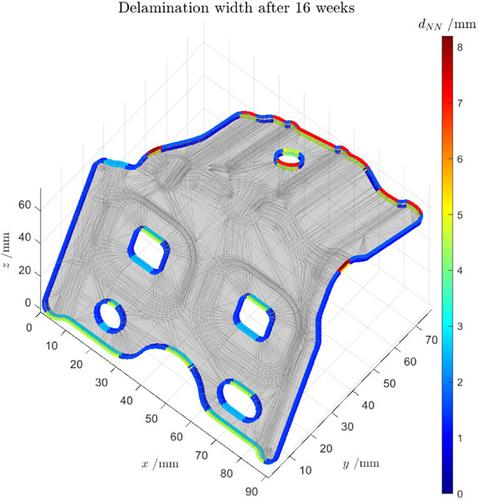当前位置:
X-MOL 学术
›
Mater. Corros.
›
论文详情
Our official English website, www.x-mol.net, welcomes your
feedback! (Note: you will need to create a separate account there.)
Edge delamination width prediction of 3D body-in-white part by finite element-based corrosion simulation and neural networks
Materials and Corrosion ( IF 1.6 ) Pub Date : 2021-08-03 , DOI: 10.1002/maco.202112637 Ludwig Waibel 1 , Konstantin Kapfer 1 , Christoph Hepfner 1 , Andreas Mittelbach 1 , Stefan Funken 2 , Lutz Krüger 3
Materials and Corrosion ( IF 1.6 ) Pub Date : 2021-08-03 , DOI: 10.1002/maco.202112637 Ludwig Waibel 1 , Konstantin Kapfer 1 , Christoph Hepfner 1 , Andreas Mittelbach 1 , Stefan Funken 2 , Lutz Krüger 3
Affiliation

|
The edge corrosion simulation of Kapfer et al. is used to extract time-dependent delamination widths of metal sheet edges with different spatial orientations, encoded by edge classes and angular displacements with respect to the ground. The corrosion behavior of the edges of a body-in-white part is examined with respect to the spatial orientation and compared to the simulated delamination widths, demonstrating that the edge corrosion simulation is also able to model more complex structures. Since scaling the finite element method-based corrosion simulation to the whole part requires a lot of memory and computational time, different neural network types are evaluated to predict the delamination widths. Together with the geometric properties of the part edges, a fast and accurate prediction of edge delamination of body-in-white parts is possible, requiring few time-consuming corrosion simulations only in the training phase of the networks.
中文翻译:

基于有限元腐蚀模拟和神经网络的 3D 白车身零件边缘分层宽度预测
Kapfer 等人的边缘腐蚀模拟。用于提取具有不同空间方向的金属板边缘的时间相关分层宽度,由边缘类别和相对于地面的角位移编码。白车身零件边缘的腐蚀行为在空间方向上进行了检查,并与模拟的分层宽度进行了比较,这表明边缘腐蚀模拟还能够模拟更复杂的结构。由于将基于有限元方法的腐蚀模拟扩展到整个零件需要大量内存和计算时间,因此评估不同的神经网络类型以预测分层宽度。结合零件边缘的几何特性,可以快速准确地预测白车身零件的边缘分层,
更新日期:2021-08-03
中文翻译:

基于有限元腐蚀模拟和神经网络的 3D 白车身零件边缘分层宽度预测
Kapfer 等人的边缘腐蚀模拟。用于提取具有不同空间方向的金属板边缘的时间相关分层宽度,由边缘类别和相对于地面的角位移编码。白车身零件边缘的腐蚀行为在空间方向上进行了检查,并与模拟的分层宽度进行了比较,这表明边缘腐蚀模拟还能够模拟更复杂的结构。由于将基于有限元方法的腐蚀模拟扩展到整个零件需要大量内存和计算时间,因此评估不同的神经网络类型以预测分层宽度。结合零件边缘的几何特性,可以快速准确地预测白车身零件的边缘分层,











































 京公网安备 11010802027423号
京公网安备 11010802027423号